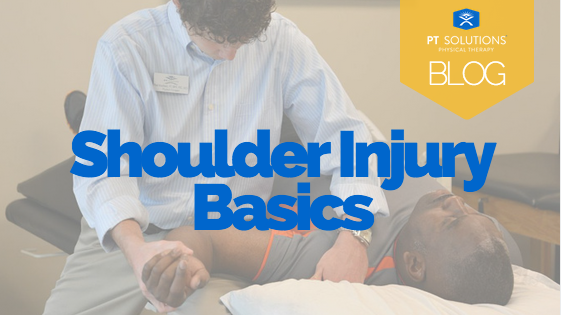Shoulder Injury Basics

The shoulder is one of the most complex joints in the body. The ideal shoulder has good muscular strength, stabilization, and flexibility. Anatomically, the shoulder consists of a ball-and-socket joint, which allows for both a high range of motion, as well as possible instability. The rotator cuff muscles — supraspinatus, infraspinatus, teres minor, and subscapularis — are responsible for keeping the ball within the socket. The third anatomical aspect of the shoulder is the labrum, which is a piece of cartilage that allows the shoulder to glide smoothly in many different directions.
While the general population suffers from shoulder injuries quite frequently, “overhead athletes” — individuals who play sports like volleyball, baseball, softball, and tennis — experience them at an even higher rate. Furthermore, their injuries often require orthopaedic intervention or physical therapy protocols to return to play.
Some athletes will experience general muscle soreness within the rotator cuff muscles due to overuse or poor strength. If one of the four key muscles is compromised because of this overuse or poor strength, then compensation takes over and other larger muscle groups may get involved. For example, a common athletic shoulder injury is bicep tendonitis. This is typically caused when the supraspinatus is not firing properly, therefore the bicep muscle must activate more to lift the arm. Bicep tendonitis normally presents with sharp pain in the front of the shoulder and the athlete may hear or feel a pop in the same area.
Rotator cuff muscles can also tear, which can lead to orthopaedic referral, diagnostic imaging, physical therapy, and sometimes surgery. The first signs and symptoms of a rotator cuff tear are shoulder weakness, radiating pain into the upper arm, and limited range of motion. Labrum injuries are normally caused by impact to the shoulder and result in deep pain in the shoulder joint as well as clicking.
All athletes should be open and honest with their coaches and athletic trainers about shoulder pain so the issue can be dealt with promptly and safely. The first step with any shoulder injury is to get evaluated by a medical professional that will create the best protocol for optimal healing.
Overuse injuries to this area are best treated with time off and rest. If the injury is more severe then orthopaedic surgery is sometimes required to repair the shoulder. Physical therapy is a quality treatment that is used conservatively and post-operatively with very beneficial results. It has been found that physical therapy is the best way to return to play for most upper extremity injuries and the treated athletes tend to return to the field stronger and healthier.
If you think you might be suffering from a shoulder injury, schedule a consultation with one of our physical therapists to get on the path to recovery. If you have already been referred for your shoulder injury, request an appointment.